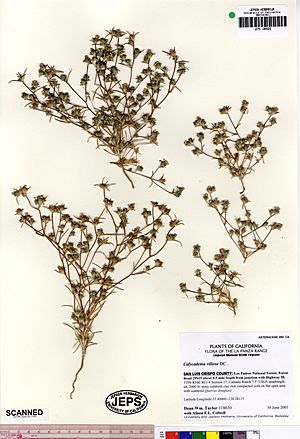Dwarf western rosinweed facts for kids
Quick facts for kids Dwarf western rosinweed |
|
|---|---|
 |
|
| herbarium specimen | |
| Conservation status | |
| Scientific classification | |
| Kingdom: | |
| (unranked): | |
| (unranked): | |
| (unranked): | |
| Order: | |
| Family: | |
| Genus: | |
| Species: |
C. villosa
|
| Binomial name | |
| Calycadenia villosa |
|
| Synonyms | |
|
|
Calycadenia villosa, also known as the dwarf western rosinweed, is a special kind of flowering plant. It belongs to the daisy family. This plant is quite rare.
It grows only in central California. You can find it in the Central Coast Ranges. Most of these plants live in Monterey County and San Luis Obispo County. A few can also be found in Santa Barbara and western Fresno Counties. There are only about 16 known places where this plant grows.
Contents
What is the Dwarf Western Rosinweed?
The dwarf western rosinweed is an annual herb. This means it completes its whole life cycle in one year. It grows from a seed, flowers, produces seeds, and then dies.
How Does It Look?
This plant has a very hairy stem that stands straight up. It can grow to be about 40 centimeters (16 inches) tall. Its leaves are long and narrow, like lines. They can be up to 5 centimeters (2 inches) long.
The plant's flowers grow in clusters. These clusters are called flower heads. Small, sticky gland-tipped bracts surround each flower head.
What Are Its Flowers Like?
Each flower head is smooth and does not have hairs. It is made up of many tiny disc florets. These are the small flowers in the center of the head. There are also one to four white or pink ray florets. These are the petal-like flowers around the edge.
Each ray floret has three small parts, or lobes. The middle lobe is the thinnest one. After the flowers bloom, they produce fruit. The fruit is a type of seed called an achene. The seeds from the disc florets have a pappus. This is a crown of scales that helps the seeds spread.
Where Does This Plant Live?
The dwarf western rosinweed is endemic to central California. This means it naturally grows only in this specific area. It needs the right conditions to thrive. Because it only grows in a few places, it is considered uncommon. Scientists work to protect these special plants.


